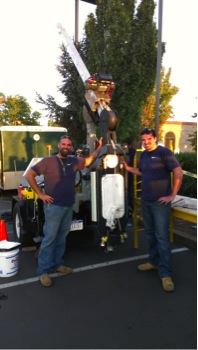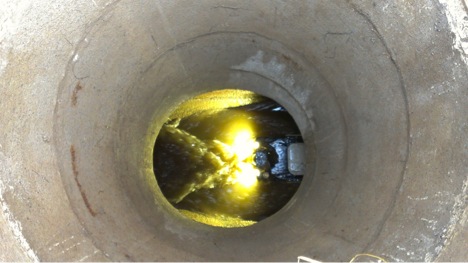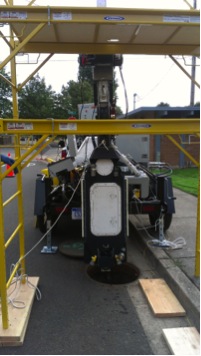Inspection of Partially Flooded Interceptors and Fully Flooded Siphons
Hibbard Inshore used 2 vehicles to complete all phases of the requested inspections: a swimming vehicle to address fully flooded sections with sediment that would restrict a crawler (siphons), and a floating vehicle for partially filled lines with sediment. The sewer lines were not cleaned prior to inspection. The swimming and floating vehicles were both mobilized to site to allow for the proper piece of equipment to be used for each section of the interceptors based upon water levels. Each vehicle was deployed from the Hibbard Inshore Inspection Trailer which was backed up to each access manhole. The inspections covered approximately 42,000 feet of gravity sewer lines.
Large Diameter Partially Flooded lines
The inspection of the partially flooded lines which ranged from 48” to 120” was performed with a floating vehicle designed for large diameter partially flooded sewer inspection. The vehicle was winched either downstream or with a second hauling winch, upstream through the sewer. The distance that could be traveled was limited by obstructions, too many bends or the 5000’ length of the tether. The project access points were planned based on the supplied drawings to optimize the deployment locations to make the best use of the 5000’ range of the system.
 Hibbard Inshore Floating Vehicle on Winch
Hibbard Inshore Floating Vehicle on Winch
The float was configured with lighting and two cameras for the inspection above the water. One camera was a pan and tilt with zoom for close up inspection of specific features and the second camera was configured with a wide angle lens for an overall view of the sewer.
The portion of the sewer that was below the water line was inspected with two sonar units. The first sonar unit was a forward looking imaging unit to locate cracks, joints and debris. The image from the sonar could look along the invert of the sewer pipe to a range of 20’ or more depending on water depth. The second sonar was a profiling sonar that created a cross section of the underwater portion of the pipe, with sufficient water depth. The cross section could measure debris depth and invert failures.
Each access point had the air quality checked for LEL’s, CO and O2 before inserting the float. The float is waterproof and submersible but the safety of the crew and topside equipment was also considered. The float was deployed by the tether winch system at the access point. Once the float was in the flow of the sewer the tether counter was set to 0’. Then the float was winched downstream recording video, sonar and features. The data acquisition system collected the video from both video cameras as well as a video version of the sonar synchronized with the notes, date, time and tether payout. The sonar was also recorded with the native sonar program so high resolution records could be maintained. A still image of the sonar was recorded at 200’ increments and for significant features. The tether counter measured the payout in feet and the measurement was overlaid on the video and recorded within the recording system. The payout of the tether was used to locate all features within the sewer.
The float was successful in completing many long stretches of sewer including navigation around bends. This reduced the number of access points necessary and reduced disruptions to traffic in many instances. The ability of the float to move in both the upstream and downstream directions allowed for further flexibility.
 Float Passing Manhole
Float Passing Manhole
Flooded Siphons
The city was looking for a single inspection provider who could not only handle their partially filled, large diameter lines but also handle inspection of all of the siphons along the two interceptors. These had proven to be difficult for the city to inspect in the past because they could not be pumped down safely or effectively in many cases. Hibbard Inshore was selected because they could provide a solution to this issue and inspect the siphons while they remained fully flooded. The siphons were inspected with a swimming ROV for this project. The access into each siphon was through a chamber with a single 24” manhole access point. Air quality and the confined entry required that the entry team use surface supplied air. The chambers were vented to reduce the LEL’s to a safe level, and then the confined entry person entered the chamber at the downstream end of the siphon. The ROV was lowered through the 24” access point and the confined entry person placed the ROV into one of the siphon pipes. The ROV was capable of swimming against some flow even with sewer solids present because it was selected for its high thrust to size capabilities, but in many cases this was not necessary for this project. The three siphon tubes were at different elevations separated by weirs, and a pipe plug was used to control which siphon tubes the flow would be moving through at a given time so that the ROV could inspect each tube while its flow was blocked.
 Float Being Lowered into Manhole
Float Being Lowered into Manhole
The portion of the sewer that was below the water line was inspected with two sonar units. The first sonar was forward looking imaging sonar to locate cracks, joints and debris. The image from the sonar could look along the invert of the sewer pipe to a range of 20’ or more depending on water depth. The second sonar unit was a profiler unit that created a cross section of the underwater portion of the pipe, with sufficient water depth. The cross section could measure debris depth and invert failures.
Video was recorded but was able to image very little because of the turbidity of the water. The sonar was used as the primary inspection sensor. The tether payout was used to measure location of features and the 20’ increments for sonar records. The data was collected in the same data acquisition recording system as the partially flooded lines.
Confined entry permits were generated at site each day and a work sequence was followed closely for safety.
Conclusion
Hibbard Inshore was able to inspect two long interceptor lines with many bends, varying diameters, and fully flooded siphon sections. They were able to collect data both above and below the waterline to allow the city to classify the pipes in terms of their repair and replacement needs meeting the city’s overall goal for the project within the city’s projected project timeline and on budget.

